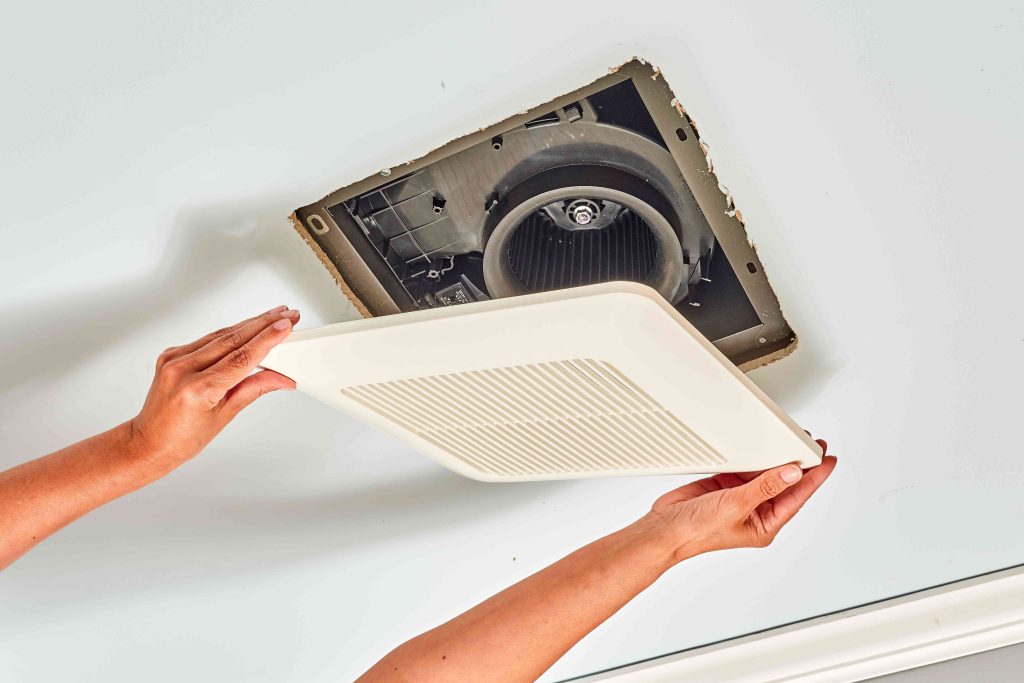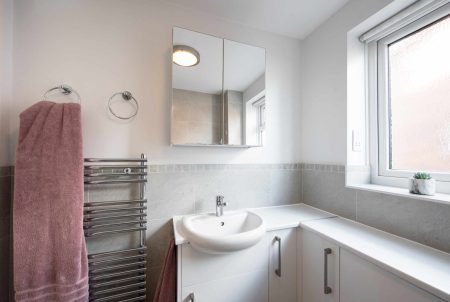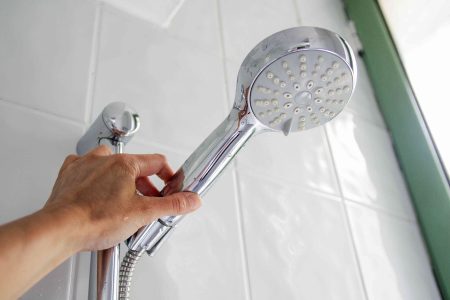Installing a bathroom fan is the solution you need for spaces that never seem to get dry. Moisture-laden air is the enemy of bathroom paint, windows, doors, window sills, and fabrics such as towels and curtains. Expelling bathroom moisture and odors makes for a far more pleasant bathroom experience for all.
While bathroom exhaust fan installation is not the easiest home improvement project, the bulk of the work is centered around the physical rigors of standing on a ladder and working above your head, along with the more taxing work of crouching in your attic while wearing a dust mask or respirator. Aside from the physical work, bathroom vent fan installation is not difficult to understand, as it involves only one 120V power source and one run of flexible ducting that extends no more than 6 feet.
Before You Begin
Two issues often concern homeowners taking on this project: power and venting to the outside. Most residential bathroom fans use AC 120V electrical lines. These instructions offer tips for finding live electrical cables and running them to the correct location.
Venting means that after air from the bathroom is drawn into the exhaust fan, it is blown through a connected flexible duct and out of the house through a hole in the side of the house or roof. Since this is a new installation, not a replacement, your bathroom will not have ducts in place. However, as long as you can access the attic area above the bathroom ceiling, you will be able to route the flexible tubing outside.
Turn off the electricity to the existing ceiling light by flipping off the circuit breaker at the service panel. Locate your attic access door and enter it via the ladder, bringing your respirator and your portable light with you.
Click Play to Learn How to Properly Install a Bathroom Exhaust Fan
What You’ll Need
Equipment / Tools
- 6-foot ladder
- Safety glasses
- Dust mask or respirator
- Reciprocating saw
- Cordless drill
- 1/2-inch drill bit
- Pencil
- Drywall jab saw
- Stud finder
Materials
- 1 Bathroom exhaust fan
- 6 foot flexible ducting
- 1 Aluminum foil tape
- Screws
- 1 Round wall vent or roof vent cap
- Exterior grade silicone caulk
Instructions
-
Find or Establish the Power Source
The bathroom vent fan will be installed in the ceiling. You may already have power running to the exact point where you intend to install the bathroom vent fan. Depending on your local electrical code, you may be able to share your bathroom lighting circuit with the fan. The bathroom lighting circuit usually supplies power to your bathroom’s ceiling light. Alternatively, you can substitute the light for a fan/light combination.
If your code requires you to run a dedicated circuit for the fan, you can run a new cable from the service panel to the bathroom ceiling area. If you do not feel comfortable establishing new circuits and working with the service panel, this would be time to contact an electrician to complete this task.
-
Locate the Vent Point
Air exhausted by the fan must exit outdoors. Thus, you will need to run a duct from the fan to either the roof or a side wall. If at all possible, run the flexible ducting to a wall, as this helps you avoid shingle work and the possibility of roof leaks.
Ideally, the rule of thumb for vent location is to choose a spot that is a direct route from the fan to the outside and 6 feet or less away from the bathroom fan to the exit point. The vent fan needs to be in the bathroom interior, not in a hallway, and should be located close to the shower, tub, or shower/tub combination, as this is the area that produces the most moisture. The duct leading from the vent should be as straight as possible to avoid sharp bends that can impede airflow.
Drill a locator hole at the center of the intended location.
-
Cut the Exterior Vent Location
Depending on where you intend to exhaust to the exterior, access either the wall or the roof of the house.
Bring your round vent (for walls) or vent cap (for roofs). Also bring your reciprocating saw, cordless drill, pencil, and silicone caulk. Situate the round vent or vent cap across the locator hole. With the pencil, scribe a circle where the vent or cap will fit.
Use the reciprocating saw to cut the circle, with the locator hole as a start point for the saw blade. Attach the round vent or roof cap with screws, first applying silicone caulk to ensure a watertight fit.
On a roof, you will need to slip the flashing of the roof cap under the shingles above the midsection of the vent opening to ensure a watertight installation. This may require removing some shingle nails and/or trimming the surrounding shingles to fit around the roof cap.
-
Cut the Interior Opening for the Bathroom Fan
From below, use the stud finder to locate the joists in the bathroom ceiling and lightly mark with a pencil.
If the fan comes with a paper template, use the template to mark the intended location of the fan in the ceiling. If there is no template, use the metal fan housing itself (leave the fan assembly out for now). Many bathroom fans screw directly to the side of the joist. If so, place the template or housing parallel to a joist when making the cut lines.
Cut out the drywall carefully with the jab saw.
-
Attach the Bathroom Fan to the Joist
Access the attic and bring your light, cordless drill, screws, and bathroom fan housing. Place the fan in the cut-out hole so that the bottom edge of the fan is flush with the bottom of the ceiling drywall. You will need a partner for this step, as you cannot see the ceiling from this position.
Screw the fan into the side of the joists with the cordless drill. If you cannot use the side of a joist as an attachment point, your fan may come with suspension brackets. If not, you can purchase these separately. Brackets will allow the fan to be suspended in a position that is not adjacent to a joist.
While you are still in the attic, fit the electrical wire through the side of the housing so that roughly 7 inches of the wire extends into the housing.
-
Route the Bathroom Fan to the Exterior
Go back down to the bathroom and verify the vertical placement of the fan. Gather your flexible ducting and aluminum foil tape and take it back into the attic. Use the foil tape to attach the flexible tubing to the fan and the vent. (Your fan or ducting may come with mechanical fasteners for attaching the duct to use instead of foil tape.) Ensure that the tubing runs as smoothly and directly as possible.
-
Attach the Bathroom Fan to the Housing
In the bathroom, insert the fan unit into the housing, per the manufacturer’s instructions. At this point, you will strip the ends of the electrical wires and hard-wire them into the unit. Typically, either a bare wire or green wire will attach to the side of the metal housing for grounding, a critical safety measure.
Attach the fan grille to the face of the housing. Turn the circuit breaker back on. Return to the bathroom and test the fan by turning on the switch.
Read the full article here














